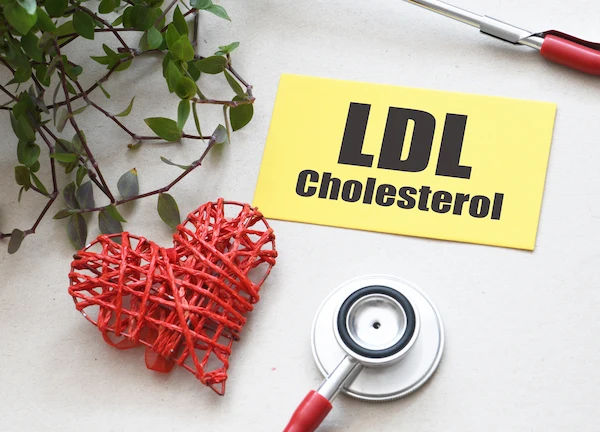Understanding Cholesterol And Stroke: How High Cholesterol Levels Impact Your Risk Of Stroke
Learn about the link between cholesterol levels and stroke risk. Understand how high cholesterol affects your cardiovascular health and the steps you can take to reduce your risk of stroke.

Written by
Last updated on 3rd Jul, 2025
Introduction
Cholesterol is a waxy, fat-like substance found in every cell of your body. It plays a vital role in many important functions, such as building cell membranes, producing hormones, and aiding in the digestion of food. While your body needs cholesterol to function properly, having high levels of certain types of cholesterol can lead to serious health problems, including an increased risk of stroke. Understanding the link between cholesterol and stroke is crucial for managing your cardiovascular health and making lifestyle choices that can help reduce your risk. This article will provide a clear overview of cholesterol, how it relates to stroke risk, and practical advice on how to manage your cholesterol levels to protect your health.
Understanding Cholesterol and Its Impact on Stroke Risk
Cholesterol is a waxy, fat-like substance that is essential for various functions in your body, including building cell membranes and producing hormones. It is produced by the liver and can also be found in certain foods like meat and dairy products. Cholesterol travels through the bloodstream and is attached to proteins called lipoproteins. There are two primary types of cholesterol that influence your health in different ways:
Low-Density Lipoprotein (LDL): Often referred to as "bad" cholesterol, LDL contributes to the buildup of fatty deposits (plaques) in the arteries. These plaques can cause the arteries to narrow and stiffen, a condition known as atherosclerosis, which can increase the risk of cardiovascular events, including stroke.
High-Density Lipoprotein (HDL): Known as "good" cholesterol, HDL helps remove excess cholesterol from the bloodstream and transports it back to the liver, where it is processed and eliminated. Higher levels of HDL are beneficial and can help reduce the risk of stroke.
How Cholesterol Affects Stroke Risk
A stroke occurs when the blood supply to part of the brain is disrupted or blocked, depriving brain tissue of the oxygen and nutrients it needs to function. There are two main types of strokes that are associated with cholesterol-related artery damage:
Ischemic Stroke: This is the most common type, accounting for about 87% of all strokes. It happens when a blood clot blocks or narrows an artery leading to the brain. Elevated levels of LDL cholesterol can cause the buildup of plaques in the arteries, which increases the likelihood of blood clots forming. These clots can block an artery that supplies blood to the brain, causing an ischemic stroke.
Hemorrhagic Stroke: This occurs when a blood vessel in the brain ruptures, causing bleeding in or around the brain. High cholesterol can contribute to the weakening of blood vessel walls, making them more prone to rupture. This increases the risk of a hemorrhagic stroke.
Mechanisms Behind the Link Between Cholesterol and Stroke
Understanding the processes through which cholesterol influences stroke risk can help clarify why managing cholesterol levels is so important:
Plaque Formation: High levels of LDL cholesterol can lead to the accumulation of fatty plaques within the arterial walls. Over time, these plaques may become unstable and rupture, triggering the formation of blood clots. If a clot travels to an artery in the brain and blocks the flow of blood, it can result in an ischemic stroke.
Inflammation: The buildup of cholesterol-related plaques in the arteries can also provoke chronic inflammation. Inflammatory processes can weaken the arterial walls and make them more susceptible to damage, including rupture. This increases the risk of both ischemic and hemorrhagic strokes.
Reduced Blood Flow: As plaques accumulate, they can significantly narrow the arteries, restricting blood flow to the brain. This can lead to transient ischemic attacks (TIAs), which are brief episodes of blocked blood flow that often serve as warning signs of an impending stroke. TIAs may be followed by a full-blown stroke if the blood flow is not restored.
Risk Factors for High Cholesterol and Stroke
Several factors can contribute to high cholesterol levels and increase your risk of stroke, including:
Diet: Consuming foods high in saturated fats, trans fats, and cholesterol can raise LDL cholesterol levels.
Lack of Physical Activity: Physical inactivity can lead to weight gain and higher LDL cholesterol levels while reducing HDL cholesterol.
Obesity: Excess body weight is associated with higher LDL cholesterol levels and lower HDL cholesterol.
Smoking: Smoking damages blood vessels and lowers HDL cholesterol levels.
Genetics: Family history can play a significant role in your cholesterol levels and stroke risk.
Age and Gender: Cholesterol levels tend to rise with age, and men are generally at higher risk of high cholesterol and stroke at a younger age compared to women.
Managing Cholesterol to Reduce Stroke Risk
Reducing your cholesterol levels is a critical step in lowering your stroke risk. Here are some actionable tips to help you manage your cholesterol effectively:
Adopt a Heart-Healthy Diet:
Increase Fiber Intake: Foods rich in soluble fibre, such as oats, beans, lentils, and fruits, can help lower LDL cholesterol levels.
Choose Healthy Fats: Replace saturated and trans fats with healthier options like monounsaturated and polyunsaturated fats found in olive oil, avocados, nuts, and fatty fish.
Limit Cholesterol Intake: Reduce consumption of high-cholesterol foods like red meat, full-fat dairy products, and fried foods.
Eat Plenty of Fruits and Vegetables: These foods are low in calories and high in nutrients, promoting overall cardiovascular health.
Engage in Regular Physical Activity:
Aim for at least 150 minutes of moderate-intensity aerobic exercise or 75 minutes of vigorous-intensity exercise per week. Activities like walking, swimming, cycling, and dancing can help raise HDL cholesterol and lower LDL cholesterol.
Maintain a Healthy Weight:
Losing even a small amount of weight can significantly improve your cholesterol levels and reduce your stroke risk. Focus on gradual, sustainable weight loss through a combination of healthy eating and regular exercise.
Quit Smoking:
Smoking cessation can improve HDL cholesterol levels and overall cardiovascular health. Seek support from healthcare providers, support groups, or smoking cessation programs to help you quit.
Limit Alcohol Consumption:
Excessive alcohol intake can raise LDL cholesterol levels and increase stroke risk. If you choose to drink, do so in moderation—up to one drink per day for women and up to two drinks per day for men.
Take Medications as Prescribed:
If lifestyle changes alone are not enough to manage your cholesterol levels, your healthcare provider may prescribe medications such as statins. Be sure to take these medications as directed and follow up regularly with your healthcare provider.
Regular Cholesterol Monitoring
Regular cholesterol monitoring is crucial for managing your cholesterol levels and lowering your risk of stroke. The American Heart Association recommends that adults aged 20 and older have their cholesterol levels checked every four to six years. However, if you have risk factors for stroke or heart disease—such as a family history, high blood pressure, or diabetes—your healthcare provider may suggest more frequent testing. Keeping track of your cholesterol levels allows for early detection of any changes so that you can take timely action to reduce your risk of both heart complications and stroke.
Get Your Cholesterol Levels Checked
Conclusion
The link between cholesterol and stroke highlights the crucial role of managing cholesterol levels in protecting cardiovascular health. By making heart-healthy choices—such as following a balanced diet, staying physically active, maintaining a healthy weight, quitting smoking, and taking prescribed medications—you can significantly lower your cholesterol and reduce your risk of stroke. Regular check-ups and proactive management of cholesterol are essential for preventing potential health complications, including stroke. By taking these steps, you can enjoy a healthier life with a reduced risk of stroke and other cardiovascular issues.
Consult Top Cardiologist
Consult Top Cardiologist

Dr. Sarita Rao
Cardiologist
17 Years • MBBS, DM (Cardiology)
Indore
Apollo Hospitals Vijay Nagar, Indore

Dr. Ramalinga Reddy
General Physician
5 Years • MBBS MD General medicine
Bengaluru
PRESTIGE SHANTHINIKETAN - SOCIETY CLINIC, Bengaluru

Dr. Bhethala Sharan Prakash
General Physician/ Internal Medicine Specialist
5 Years • MBBS MD
Bengaluru
PRESTIGE SHANTHINIKETAN - SOCIETY CLINIC, Bengaluru

Dr. Anand Ravi
General Physician
2 Years • MBBS
Bengaluru
PRESTIGE SHANTHINIKETAN - SOCIETY CLINIC, Bengaluru

Dr. Abhishek Rathore
Cardiologist and Electrophysiologist
7 Years • MBBS, MD (Gen. Medicine), DM ( Cardiology ), Post-Doctoral Fellowship in Cardiac Electrophysiology.
Indore
Apollo Hospitals Vijay Nagar, Indore
Get Your Cholesterol Levels Checked
₹250(₹625)60% off




 (1).webp)